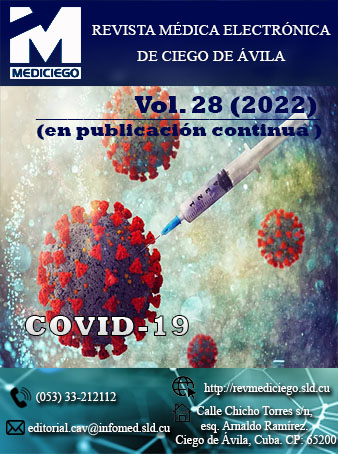Fragmented and calcified double J catheter in obstructed kidney. Case report
Keywords:
catheters, cystoscopy, renal colic, nephrolithiasis, covid-19Abstract
Introduction: the kidneys maintain an adequate balance of fluids in the body, remove waste and eliminate toxins from the blood. The ureteral catheter is used when there is obstruction to open the ureter and allow the passage of urine from the kidney to the bladder.
Objective: to present the clinical situation of a patient who had a left double J catheter inserted and who presented complications as a result of COVID-19.
Presentation of the case: a 37-year-old female patient with a history of being a habitual expeller of lithiasis; She has undergone surgery on several occasions for lithiasis of the right kidney. She had a left double J catheter inserted due to ureteropelvic junction stenosis. During the pandemic, it was not possible to change the catheter in the established time, nor to remove it endoscopically. Therefore, the open procedure was planned and could not be carried out either. The patient came eight months later with a picture of renal colic and acute renal failure. Emergency surgery is carry out. A nephrostomy and a simple ureteral catheter were left through the orifice, which were removed after a month. The results and evolution were satisfactory.
Conclusions: after emergency surgery for the calcified and fragmented double J catheter in the obstructed kidney, the patient had a favorable evolution with follow-up in consultation with renal ultrasound and blood chemistry tests, with normal results
Downloads
References
Flores-Lombeyda GA, Chung-Villavicencio JR, Veletanga-Mena AV, Carbo-Palacio JA. Riesgo-Beneficio en el uso del catéter doble J en pacientes con insuficiencia renal aguda. RECIAMUC [Internet]. 2019 [citado 20 Jun 2021];3(3):137-52. Disponible en: http://reciamuc.com/index.php/RECIAMUC/article/view/271
López-Baltodano EE. Manejo de pacientes con catéteres doble J calcificados atendidos en el servicio de urología del hospital escuela “Dr. Antonio Lenin Fonseca” de enero 2017 a enero 2019 [Internet]. Managua: Universidad Nacional Autónoma de Nicaragua 2019 [citado 20 Jun 2021]. Disponible en: https://repositorio.unan.edu.ni/13449/1/TESIS%20FINAL.pdf
Papaginovic-Leiva MM, Nicolini ME, Serrano MH, Mojico ER, Martínez RD. Litiasis coraliforme con calcificación bilateral de catéteres doble J como causa de ingreso a diálisis, su evolución y complicaciones. Rev Nefrol Dial Traspl [Internet]. 2019 [citado 20 jun 2021];39(3):224-27. Disponible en: http://vps-1689312-x.dattaweb.com/index.php/rndt/article/download/470/919
Muruato-Araiza JS, Reyna-Blanco I, Jimenez-García A, Martínez-Salas A, Lopez-Maguey R, Hernandez-Mendez A, et. al. Manejo postoperatorio de catéter doble J en ureteroscopias, síntomas y complicaciones. Rev Mex Urol [Internet]. 2019 [citado 20 jun 2021];79(6):1-6. Disponible en: https://www.medigraphic.com/pdfs/uro/ur-2019/ur196c.pdf
Coronel-Durazno MJ, Pachucho-Pizarro CO. Complicaciones postoperatorias del catéter doble J en pacientes con uropatía obstructiva en el hospital de la policía nacional Guayaquil - 2 desde enero 2016 hasta mayo 2018 [Internet]. Guayaquil: Universidad Católica de Santiago de Guayaquil; 2019 [citado 20 jun 2021]. Disponible en: http://repositorio.ucsg.edu.ec/bitstream/3317/12931/1/T-UCSG-PRE-MED-790.pdf
Camacho-Castro AC, Inzunza-Aguilar MC, Aceves-Tello LS, Ramírez-Hermosillo JA, López-Chávez MA, Hernández-Félix VP. Litiasis renal bilateral y catéter doble J calcificado grado V: acceso percutáneo en posición supina. A propósito de un caso. Rev Mex Uro [Internet]. 2018 [citado 20 jun 2021];78(4):310-14. Disponible en: http://www.scielo.org.mx/pdf/rmu/v78n4/2007-4085-rmu-78-04-310.pdf
Published
How to Cite
Issue
Section
License
Copyright (c) 2023 Lesyibeth Rodríguez Cruzata

This work is licensed under a Creative Commons Attribution-NonCommercial 4.0 International License.
Those authors who have publications with this journal accept the following terms of the License CC Attribution-NonCommercial 4.0 International (CC BY-NC 4.0):
You are free to:
- Share — copy and redistribute the material in any medium or format for any purpose, even commercially.
- Adapt — remix, transform, and build upon the material for any purpose, even commercially.
The licensor cannot revoke these freedoms as long as you follow the license terms.
Under the following terms:
- Attribution — You must give appropriate credit , provide a link to the license, and indicate if changes were made . You may do so in any reasonable manner, but not in any way that suggests the licensor endorses you or your use
- No additional restrictions — You may not apply legal terms or technological measures that legally restrict others from doing anything the license permits.
The journal is not responsible for the opinions and concepts expressed in the works, which are the exclusive responsibility of the authors. The Editor, with the assistance of the Editorial Committee, reserves the right to suggest or request advisable or necessary modifications. Original scientific works are accepted for publication, as are the results of research of interest that have not been published or sent to another journal for the same purpose.
The mention of trademarks of specific equipment, instruments or materials is for identification purposes, and there is no promotional commitment in relation to them, neither by the authors nor by the editor.






















